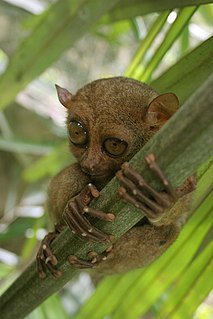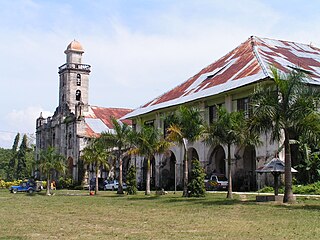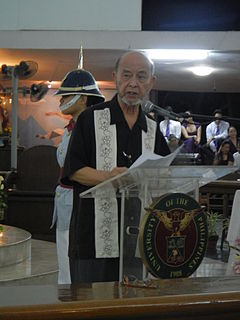
Tarsiers are haplorrhine primates of the family Tarsiidae, which is itself the lone extant family within the infraorder Tarsiiformes. Although the group was once more widespread, all of its species living today are found in the islands of Southeast Asia, specifically the Philippines, Malaysia, Indonesia, and Brunei.

Bohol, officially the Province of Bohol, is an island province of the Philippines located in the Central Visayas region, consisting of the island itself and 75 minor surrounding islands. Its capital is Tagbilaran. With a land area of 4,821 km2 (1,861 sq mi) and a coastline 261 km (162 mi) long, Bohol is the tenth largest island of the Philippines.

The Chocolate Hills are a geological formation in the Bohol province of the Philippines. There are at least 1,260 hills but there may be as many as 1,776 hills spread over an area of more than 50 square kilometres (20 sq mi). They are covered in green grass that turns brown during the dry season, hence the name.

The Philippine tarsier, known locally as mawumag in Cebuano and other Visayan languages, and magô in Waray, is a species of tarsier endemic to the Philippines. It is found in the southeastern part of the archipelago, particularly on the islands of Bohol, Samar and Leyte. It is a member of the approximately 45-million-year-old family Tarsiidae, whose name is derived from its elongated "tarsus" or ankle bone. Formerly a member of the genus Tarsius, it is now listed as the only member of the genus Carlito, a new genus named after the conservationist Carlito Pizarras.

Tagbilaran, officially the City of Tagbilaran, is a 3rd class component city and capital of the province of Bohol, Philippines. According to the 2020 census, it has a population of 104,976 people.

Corella, officially the Municipality of Corella, is a 5th class municipality in the province of Bohol, Philippines. According to the 2020 census, it has a population of 9,479 people.

Alburquerque, officially the Municipality of Alburquerque, is a 5th class municipality in the province of Bohol, Philippines. It had a population of 11,246 people at the time of the 2020 census.

Baclayon, officially the Municipality of Baclayon, is a 4th class municipality in the province of Bohol, Philippines. According to the 2020 census, it has a population of 22,461 people.

Loboc, officially the Municipality of Loboc, is a 4th class municipality in the province of Bohol, Philippines. According to the 2020 census, it has a population of 17,418 people.

Loon, officially the Municipality of Loon, is a 2nd class municipality in the province of Bohol, Philippines which was established in 1753. According to the 2020 census, it has a population of 44,224 people.

Talibon, officially the Municipality of Talibon, is a 1st class municipality in the province of Bohol, Philippines. According to the 2020 census, it has a population of 71,272 people.

Holy Name University is a private, Catholic co-educational basic and higher education institution run by the Society of the Divine Word in Tagbilaran City, Bohol, Philippines. It was founded by Fr. Alphonse G. Lesage, SVD a Divine Word Missionary in 1947. It offers programs in elementary, secondary and tertiary levels. Its tertiary offerings include courses in Arts and Sciences (CAS),

Edgardo Migriño Chatto, more commonly known as Edgar Chatto, is a Filipino lawyer and politician who is currently the Representative of the 1st Legislative District of Bohol since 2019. He previously served in that position from 2001 to 2010.

The Sandugo was a blood compact, performed in the island of Bohol in the Philippines, between the Spanish explorer Miguel López de Legazpi and Datu Sikatuna the chieftain of Bohol on March 16, 1565, to seal their friendship as part of the tribal tradition. This is considered as the first treaty of friendship between the Spaniards and Filipinos. "Sandugo" is a Visayan word which means "one blood".

The Immaculate Heart of Mary Seminary or IHMS, located at Pacifico Cabalit St., Taloto, Tagbilaran City, Bohol, Philippines, is a diocesan college seminary established in 1950 by Julio Rosales, Bishop of Tagbilaran, in implementation of Canon 1354, no. 2 of the 1917 Code of Canon Law that required the Bishop to establish such institution.

José Veloso Abueva was a Filipino political scientist and public administration scholar who served as the 16th president of the University of the Philippines. A Ten Outstanding Young Men (TOYM) awardee for political science in 1962, he has devoted much of his career in academic circles. He has been faculty member of the National College of Public Administration and Governance of the University of the Philippines Diliman and visiting professor at Brooklyn College, City University of New York and Yale University. He has also worked with the United Nations University in Tokyo. Abueva's service to the nation includes stints as secretary of the 1971 Constitutional Convention, executive director of the Legislative-Executive Local Government Reform Commission and Chairman of the Legislative-Executive Council that drew up the conversion program for former military bases. Abueva has written a number of books, including "Focus in the Barrio: The Foundation of the Philippine Community Development Program" and "Ang Filipino sa Siglo 21." Among the publications he has edited is the 20-volume "PAMANA: The UP Anthology of Filipino Socio-Political Thought since 1872."

The Chorus Paulinus or CHOPA is a choir in the Philippines. It is known for its a cappella-style blending of voices that creates a sound reflective of its high choral standards.
Local elections were held in the Province of Bohol on May 10, 2010, as part of the 2010 general election. Voters elected candidates for all local positions: a city or town mayor, vice mayor and town councilors, three to four members of the Sangguniang Panlalawigan, the vice-governor, governor, and representatives for the three district of Bohol. Bohol had posted an approximate total of 736,468 eligible voters based on the latest count after the deadline set on October 31, 2009, compared to a total of 695,445 voters in the 2007 election. A total of 610,494, or 82.89%, cast their votes during the election day.
















